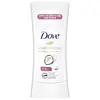What's inside
What's inside
 Key Ingredients
Key Ingredients

 Benefits
Benefits

 Concerns
Concerns

 Ingredients Side-by-side
Ingredients Side-by-side

Cocos Nucifera Oil
MaskingSolanum Tuberosum Starch
AbsorbentCoco-Caprylate/Caprate
EmollientHelianthus Annuus Seed Wax
Skin ConditioningCarthamus Tinctorius Seed Oil
MaskingPolyhydroxystearic Acid
EmulsifyingTriethyl Citrate
MaskingZinc Ricinoleate
Magnesium Hydroxide
AbsorbentLauryl Laurate
Skin ConditioningParfum
MaskingSambucus Nigra Fruit Extract
AstringentGlyceryl Laurate
EmollientSalvia Officinalis Oil
MaskingHelianthus Annuus Seed Oil
EmollientTocopherol
AntioxidantGlyceryl Caprylate
EmollientGlyceryl Undecylenate
EmollientSodium Caproyl/Lauroyl Lactylate
AntimicrobialEthylhexylglycerin
Skin ConditioningLinalool
PerfumingCocos Nucifera Oil, Solanum Tuberosum Starch, Coco-Caprylate/Caprate, Helianthus Annuus Seed Wax, Carthamus Tinctorius Seed Oil, Polyhydroxystearic Acid, Triethyl Citrate, Zinc Ricinoleate, Magnesium Hydroxide, Lauryl Laurate, Parfum, Sambucus Nigra Fruit Extract, Glyceryl Laurate, Salvia Officinalis Oil, Helianthus Annuus Seed Oil, Tocopherol, Glyceryl Caprylate, Glyceryl Undecylenate, Sodium Caproyl/Lauroyl Lactylate, Ethylhexylglycerin, Linalool
Ingredients Explained
These ingredients are found in both products.
Ingredients higher up in an ingredient list are typically present in a larger amount.
Helianthus Annuus Seed Oil is the oil derived from the seeds of a Sunflower. Sunflower seed oil is non-fragrant. It is an emollient, meaning it helps to soften the skin.
Sunflower seed oil contains many fatty acids. The fatty acids found in sunflower seeds include (from highest amount to least): linoleic acid, myristic acid, palmitic acid, stearic acid, arachidic acid, oleic acid, and linolenic acid.
These fatty acids help the skin create ceramides. Ceramides play a role in repairing the skin barrier.
Helianthus Annuus Seed Oil helps moisturize the skin. This in turn helps the skin look more rejuvenated and smoother.
Sunflowers are rich in vitamin E.
Historians believe Indigenous cultures of North America domesticated sunflowers before corn. Thus they relied on sunflower oil for a variety of uses. One such use is moisturizing skin and hair.
Sunflower seed oil may not be fungal acne safe. We recommend speaking with a professional if you have any concerns.
Learn more about Helianthus Annuus Seed OilParfum is a catch-all term for an ingredient or more that is used to give a scent to products.
Also called "fragrance", this ingredient can be a blend of hundreds of chemicals or plant oils. This means every product with "fragrance" or "parfum" in the ingredients list is a different mixture.
For instance, Habanolide is a proprietary trade name for a specific aroma chemical. When used as a fragrance ingredient in cosmetics, most aroma chemicals fall under the broad labeling category of “FRAGRANCE” or “PARFUM” according to EU and US regulations.
The term 'parfum' or 'fragrance' is not regulated in many countries. In many cases, it is up to the brand to define this term.
For instance, many brands choose to label themselves as "fragrance-free" because they are not using synthetic fragrances. However, their products may still contain ingredients such as essential oils that are considered a fragrance by INCI standards.
One example is Calendula flower extract. Calendula is an essential oil that still imparts a scent or 'fragrance'.
Depending on the blend, the ingredients in the mixture can cause allergies and sensitivities on the skin. Some ingredients that are known EU allergens include linalool and citronellol.
Parfum can also be used to mask or cover an unpleasant scent.
The bottom line is: not all fragrances/parfum/ingredients are created equally. If you are worried about fragrances, we recommend taking a closer look at an ingredient. And of course, we always recommend speaking with a professional.
Learn more about Parfum